![]()
Featured Harp Guitar of the Month
Shutt’s Harp Guitar
Prototype?
by Gregg Miner, November, 2014
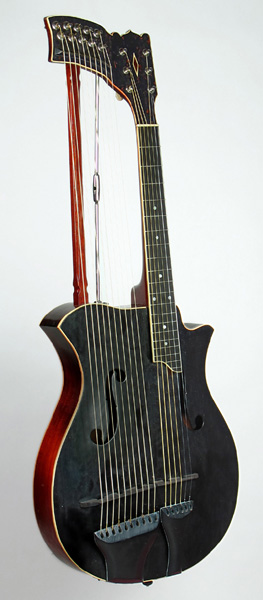 |
INTRODUCTION Before you get too excited, no, this is not the amazing Shutt Mando-Bass-Harp-Guitar. That patented and catalogued instrument has yet to be found – and it may be that only one was ever built. Equally rare – again, with only one example known from this 1912 Crescendo photo, and never found – is Shutt’s standard Sub-Bass Guitar. This wonderful discovery is neither of those. It was built by Frank J. Oppitz, a man who worked for Shutt during the very brief period of his short-lived mandolin and guitar manufacturing business. Remaining in Oppitz’ family until present day, there is, regrettably, no solid information on it. The fascinating instrument was brought to light recently by his granddaughter Jeanette Surratt. The family has long surmised that it was Grandfather Frank’s “personal instrument.” I suspect that it was built in the Shutt shop (a small “factory” on the second floor of his Topeka, Kansas home). It has no label or markings, and indeed, Frank appears to have played it quite a bit (while taking very good care of it). But did he build it as an “employee instrument” for his own amusement? Or was it something more? Taking everything into account, I find it at least equally likely that this could have been built as a first experiment or prototype for a Shutt harp guitar. |
|
|
For those unfamiliar with Shutt, you might pause here to
read my full article on
this obscure but important American maker.
Or at least my short new blog essay
on this enigmatic maker. In a nutshell, Albert Shutt was a small town music personality
who seems to have been inspired by Gibson’s instruments into competing
with them. Clearly
influenced by their instruments, he came up with many of his own
variations and “improvements” on many of Gibson’s popular
features. For example,
according to Roger
Siminoff, it was Shutt who
first introduced the elevated fingerboard extension, later used on
Gibson mandolins and guitars. Shutt
also created the first archtop mandolin
and guitar with F-holes and
patented his own elevated pickguard and compensating bridge.
He may have even
installed truss rods long before Gibson patented theirs.
Of particular interest to harp guitar historians is Shutt’s
ultimate achievement (even if it may have been something of a “white
elephant”): The Mando-Bass-Harp-Guitar, which was intended to be a perfect combination of Gibson’s popular harp guitar and brand new mandobass! |
Shutt's c.1912 Mando-Bass-Harp-Guitar with truss rod covers? |
|
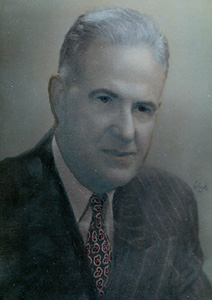
|
FRANK
J. OPPITZ Jeanette has little information on her now-historically-important grandfather, noting that “My grandfather was a master carpenter who enjoyed music as his hobby.” That he made violins is known, but whether that was his specific trade is not known. He played guitar as an amateur, and perhaps studied with Albert Shutt himself, whose main occupation was teaching banjo, mandolin and guitar. A love of music was passed down through the Oppitz family. A piano player and occasional songwriter herself, Jeanette says of Frank’s son Frank Jr.: “My father was a musician that could do anything with wood as his hobby. He played the trumpet and for years was highly involved with the Arab Shrine band in Topeka, Kansas.” Newspaper searches have revealed that Frank Oppitz Sr. played the guitar in Shutt’s mandolin orchestra groups. The first of these appearances occurred in 1911 and featured a “Guitar duo” by “Messrs. Shutt and Oppitz.” Ten years later, another appearance of Oppitz playing guitar in Shutt’s “Stringolio” club occurred in July, 1921. While the instrument manufacturing enterprise had almost certainly been abandoned by this time, the men undoubtedly kept in contact through their musical activities. It’s easy to imagine the two playing harp guitars for these concerts! |
Note Oppitz as the first witness
And again 3 years later |
|
We know they played music together from at least 1911 to 1921; when did they work together? Frank's granddaughter recently discovered that
"he was a master carpenter for the Santa Fe Railroad. (My) Dad
said that when they would strike, he would work full time for Albert
until they were called back to work. How often that happened, I
can't tell you." A couple of clues can also be found on Shutt’s
patents. Frank J. Oppitz is
one of the witnesses on Shutt’s design patent #D41792 titled “Body
for Stringed Musical Instruments” (depicting his mandolin with
newly-refined scrolls). This
was filed on May 22, 1911 and granted the same year on September 19th.
Curiously, Oppitz didn’t
witness the very next patent, which was for the mando-bass-harp-guitar
(“Double Bass Guitar”). Nor
did he appear on the following elevated pick guard patent also filed in
1912. Then his name again
appears on design patent D45969 – the plainer, asymmetrical mandolin
design – filed in March, 1914. The
late date of this patent is a conundrum I discuss on the Dating page.
I also find it interesting that this body shape (slightly
different in the patent drawing) is the one he used for his harp guitar.
Specifics or conjecture aside, we know that Oppitz was definitely
present during the peak of Shutt’s mandolin and guitar building
activities. The output of Shutt’s mini-factory is unknown, but only a dozen or so Shutt instruments are known to survive. Despite the extensive and detailed catalog along with Shutt’s several advertisements, his distinctive instruments do not seem to have found a market, and all indications are that they were produced for only a few very short years and probably through individual orders only. It’s not known whether Albert Shutt specifically built any of his instruments himself; his grandson Jack mentioned having help – “especially carving tops and backs – from violinmakers.” Though we have no hard evidence of this, we do now have some knowledge and evidence of at least one of these builders – Frank Oppitz. He even left us an example of what is allegedly his personal work. |
||
|
THE OPPITZ / SHUTT HARP GUITAR I was thrilled to acquire this personal/prototype harp guitar from the family in 2014. It was in remarkable condition for a one hundred year old instrument: only one significant open top crack and worn frets with binding issues due to the fingerboard shrinking. After restoration by my museum quality expert, it looks great (I’ve been advised not to attempt to polish or otherwise restore the black top finish). Let’s take a look: |
||
|
I believe that this may be the earliest archtop guitar with F-holes, something Shutt beat Gibson to by over a decade. The top and back are very finely carved, with a less pronounced arch than Gibson’s. The bracing and support posts are interesting to compare as one has a center soundhole while the other has opposing f-holes. The Oppitz/Shutt has a small longitudinal brace just inside the bass side f-hole. Compare this to the Gibson bracing (2 bars and a horizontal brace below the soundhole (patent drawing below). Gibson added two thick wooden support posts inside on opposite sides of the soundhole (Nov, 1908). Similarly, Oppitz installed one post in the center between the F holes. These photos show it terminating at the neck/shoulder block and tail block. Comparing further with the Gibson Style U, we see:
|
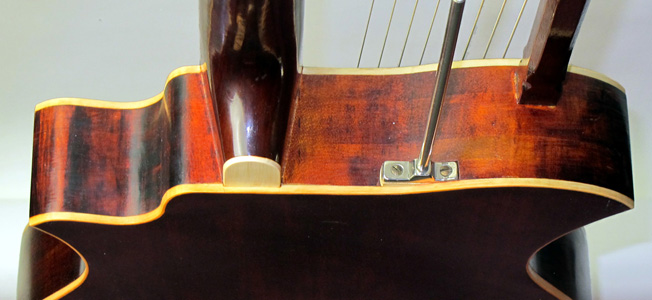 |
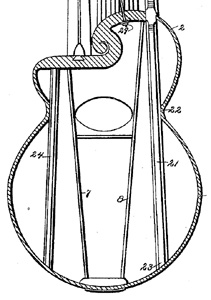 |
| Here is an interesting feature, occurring also on at least
one Shutt scroll mandolin. This
portion of the body’s upper perimeter – from point to point – are
not “sides” but a chunk of wood (maple, most likely) created from
three laminated ⅞" pieces. Totalling
2-1/2" in width, it’s about an inch in depth, spanning this whole
top perimeter, with the sides attached to it and covering the ends up to
the corners. Something similar was seen in my giant
Bohmann harp
guitar, though that extended neck-shoulder block was entirely
covered by the sides.
And it seems that the Gibson harp guitar may have its own complex version of a "super neck block" — like the Bohmann, fully covered by the sides. Again, Shutt and Oppitz had likely taken apart a Gibson or two... |
|
|
If this was a shop worker’s “personal instrument” and not a specific Shutt prototype, then it appears nevertheless to have been built like all of the Shutt shop’s output, with the same techniques and materials and plausibly at the same time. Note for example that it appears to have been built with the c.1912 “Style B” guitar mold (far right), but with the right upper shoulder moved out to accommodate the neck moving to the right (this is part of the top slab and not part of any side mold). The dimensions I believe are also roughly the same. Other similar touches include: |
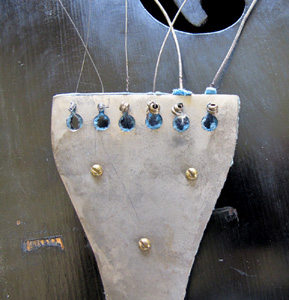 |
In the two known Shutt harp guitars, the Mando-Bass-Harp-Guitar (left) has a similar two-piece set-up; the Sub-bass Guitar (right) has a single wide one. |
|
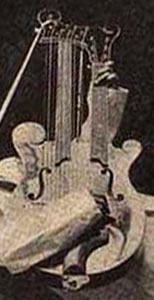 |
| Like the Gibson harp guitar, Oppitz added a support rod,
either from the onset or added later.
Interesting that the wood shim looks newer to me.
The fingerboard had shrunk in width causing the binding to “scallop.” Below: All original binding re-attached after fret dressing. |
The back and sides appear to be a plain maple, stained to look like mahogany. |
||
|
DATING Assuming that I’ve demonstrated that Oppitz built this harp guitar in the general 1911-1915 period of Shutt’s production, the next question is how it falls in line with the dating specifics of the Shutt catalog instruments and patents. That has proven to be a puzzle, as the catalog contains apparent inconsistencies. On the new Shutt
Dating page, I’ve created a chart to try to wrap my head
around it. My
detailed analysis and reasoning are there; you may wish to corroborate
or suggest alternatives. It
ends with a simple bullet re-cap, which I’ll repeat here, with an
extra bullet concerning the Oppitz harp guitar. My conclusions:
|
|
FINAL
ASSESSMENT Here is where the proud new owner would typically boast how great the instrument sounds (honestly, they can’t all sound fabulous, can they?). Well, in my collection of pretty fabulous-sounding harp guitars, this is unfortunately not one I can boast about. The thick-topped Gibson harp guitars are infamous for their surprisingly thin and dry, clunky sound. The Oppitz guitar – in virtually as-built condition – sounds inexplicably and dramatically worse in comparison. Somewhere between an old Sears guitar and a plastic Maccaferri. In fact, a gypsy-jazz rhythm “le pompe” is perhaps the one thing this instrument would work well for. |
|
|
I can’t quite understand why.
I’d always heard good things about Shutt mandolins; David
Grisman compares both the quality and tone favorably to pre-Loar Gibsons, as
do collectors Lowell Levinger and Jim Reynolds. Construction?
Design? I believe that
this was one of the very first F-hole archtop guitars ever made – ten
years before Lloyd Loar’s for Gibson (and of course Gibson harp guitars
never switched over to F-holes). Like
Orville Gibson, Albert Shutt based his instruments on violin principles. Just as Gibson Style U’s were recommended to be gut-strung, perhaps that would help here? The strings on it as received were all steel/nickel – the classic Black Diamond brand, while the subs of unknown make were also full steel, ranging from 0.040” to 0.070”. In the case were old silk and steel neck strings, and I suspect the entire instrument was originally fitted with S&S. |
|
|
Speaking of the case: The “surprise in the Cracker Jack box” for every vintage instrument collector is that moment when they first open the accessories compartment in the musty old case. This was a particularly fun one! Used and un-used vintage strings, an early capo, some extra friction tuners, and these bizarre metal fingerpicks. I’d seen an ad for these in a 1920’s Cadenza – they’re meant to grip the finger more safely I suppose. The original catalog is just the second known, and was a bonus from the owner. Regardless of the disappointing tone, this remains a rare prize in the Miner Museum. My sincere thanks to Jeanette and the family for entrusting this historical treasure to my care. |
|
|
Below left: The Shutt
Mando-Bass-Harp-Guitar. Right: Frank Oppitz/Shutt Harp
Guitar
|
|
|
Harp Guitar of the Month: Archives |
| Collectors,
Authors, Scholars: Want to create a page about a certain harp guitar
maker or instrument? Contact
me!
If you enjoyed this article, or found it useful for research, please consider supporting Harpguitars.net so that this information will be available for others like you and to future generations. Thanks!
|
|
If you enjoyed this article, or found it
useful for research, please consider making a donation to The
Harp Guitar Foundation, |
|
|
|
All Site Contents Copyright © Gregg Miner, 2004, 2005, 2006, 2007, 2008, 2009, 2010, 2011, 2012, 2013,2014. All Rights Reserved. Copyright and Fair Use of material and use of images: See Copyright and Fair Use policy. |